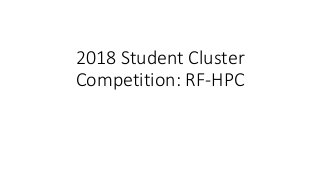
Rf hpc student cluster comp preso
- 1. 2018 Student Cluster Competition: RF-HPC
- 2. 11th Annual Competition • 14 teams total • Variety of benchmarks/applications • Benchmarks: LINPACK
- 4. Deep Learning App: Horovod • Deep learning is a class of machine learning algorithms in which layers of nonlinear processing units are used for feature extraction and transformation, with each successive layer taking the output from the previous layer as input. TensorFlow is one of the popular deep learning frameworks with parallel training functionality. Horovod acts as the communication layer of TensorFlow to accelerate the training process. Documentation and code examples of Horovod are at: https://github.com/uber/horovod .
- 5. OpenMC • OpenMC is an open source Monte Carlo particle transport code. OpenMC simulates neutrons moving stochastically through an arbitrarily defined model that represents a real-world experimental setup. The experiment could be as simple as a sphere of metal or as complicated as a full-scale nuclear reactor. Modern, portable input/output file formats are used in OpenMC: XML for input, and HDF5 for output. High performance parallel algorithms in OpenMC have demonstrated near-linear scaling to over 100,000 processors on modern supercomputers. Documentation of OpenMC can be found at: https://openmc.readthedocs.io/en/stable/ .
- 6. Reproducibility Challenge • Once again, students in the cluster competition will be asked to replicate the results of a publication from the previous year's Supercomputing conference. For this challenge, you will take on the role of reviewing an SC18 paper that contains an Artifact Description appendix to see if its results are replicable. • For the past three years, SC has promoted the adoption of the Artifact Description (AD) policy endorsed by ACM. The conference has selected one of the papers from the past edition to become the benchmark for the SC SCC reproducibility challenge. The competitive selection includes the review of all the past edition SC papers with AD and the in-person interview of the finalist papers' authors. • SeisSol • This year, the SCC committee is proud to announce the winning paper for the reproducibility challenge at this year’s SCC at SC18: "Extreme scale multi-physics simulations of the tsunamigenic 2004 sumatra megathrust earthquake". The paper is co-authored by Carsten Uphoff, Sebastian Rettenberger, and Michael Bader from Technical University of Munich and Elizabeth H. Madden, Thomas Ulrich, Stephanie Wollherr amd Alice-Agnes Gabriel from Ludwig-Maximilians-Universität München. • In the paper the authors describe the end-to-end optimization of the simulation code SeisSol (http://www.seissol.org/) that become necessary to run the extreme size of a high-resolution simulation of the 2004 Sumatra-Andaman earthquake. You will find the code that was used in this paper: https://github.com/SeisSol/SeisSol/tree/scc18 . Please make sure to take the scc18 branch.
- 7. Reproducibility Challenge 2 • The challenge will consist of two parts. One part will consist of a short interview with each team as in the other challenges. The other part will consist of a report describing your attempt to replicate the results from the paper. The report must be written in English, using a page size of US Letter, in PDF format, with 1 inch margins, and using a 12 point font size. You will also need to be able to create graphs and tables similar to those from the paper. Most importantly, in the report, you will need to explain how you got your results and compare your results to the results of the authors. Your scores will not depend on whether your results match the results in the paper. The goal of the report is to state if you can or cannot replicate the results in the paper. If you cannot replicate the paper's results, you can still obtain full points by presenting your data and explaining why you cannot replicate the paper's results. As a last note, you will only be required to report results for one compute architecture. If your cluster contains both a CPU and an accelerator, results for either one may be used for this part of the competition.
- 8. Mystery Application At the start of the competition, teams will be given an application and datasets for a mystery application. Students will be expected to build, optimize and run this mystery application all at the competition.
- 9. Power Shutoff Activity • Some time during the 45 and 1/2 hours of the general competition the power will be shut-off at least once. The exact timing of the shutdown(s) are secret and may happen day or night. • You and your team will need to know how to bring the hardware and software back from a full unscheduled power outage and how to resume any workload you were processing at that time. This exercise is designed to simulate real world events that system staff must respond to. This activity will allow your team to demonstrate their systems skills by recovering the system.
- 10. SC18 Field & Experience Team Appearances (ASC, ISC, SC combined) Gold medals Silver Medals Bronze Medals LINPACK HPCG Friedrich-Alexander University Erlangen-Nuremberg, Germany 8 1 2 Laney College, United States 0 Monash University, Australia 0 Nanyang Technological University, Singapore (The winning team from the SC17 Student Cluster Competition) 9 1 1 1 National Tsing Hua University, Taiwan 13 2 1 2 4 Northeastern University, United States 4 0 0 0 0 1 Purdue University, United States 12 1 Telkom University, Indonesia 0 Texas A&M University, United States 1 Tsinghua University, China (The winning team from the ASC18 Student Supercomputer Challenge and the ISC18 Student Cluster Competition) 15 9 2 2 1 University of Illinois at Urbana-Champaign, United States 2 University of Massachusetts, Boston, United States 0 University of Warsaw/Warsaw University of Technology/Lodz University of Technology/University of Wroclaw, Poland 3 Wake Forest University, United States 0
